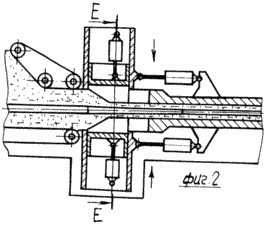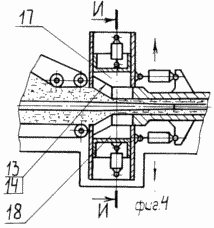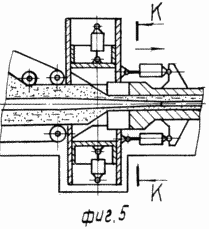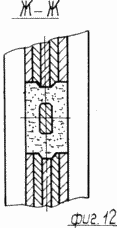| Start of section
Production, amateur Radio amateurs Aircraft model, rocket-model Useful, entertaining |
Stealth Master
Electronics Physics Technologies Inventions |
Secrets of the cosmos
Secrets of the Earth Secrets of the Ocean Tricks Map of section |
|
| Use of the site materials is allowed subject to the link (for websites - hyperlinks) | |||
Navigation: => |
Home / Patent catalog / Catalog section / Back / |
|
INVENTION
Patent of the Russian Federation RU2050272
![]()
METHOD OF MANUFACTURING A BUILDING ARTICLE FROM VEGETABLE PARTICLES AND A DEVICE FOR ITS IMPLEMENTATION
The name of the inventor: Valuev N.I . ; Gromov A.P.
The name of the patent holder: Scientific and Inventory and Production Association "NIIPA"
Address for correspondence:
The effective date of the patent: 1992.02.21
Use: production of construction products. SUMMARY OF THE INVENTION: a composition is prepared from vegetable particles, fed to form a briquette, longitudinal and transverse pressing is performed, heated and maintained, and common clamps are used for pressing and braking, and chambers are moved when the article is moved. The device used to manufacture the construction product comprises a frame, a housing, a bunker in which a briquette, a blanker and hydraulic clamps are fixed fixed to the fixed part of the housing, the profile of the product and the individual parts of the surfaces of the hydraulic clamps are equidistant, the coaxially and rigidly mounted chambers are movable relative to the frame, The pair of walls of the first chamber being elongated and supported on the body, and is provided with one-way stops for feeding the particles to the briquette.
DESCRIPTION OF THE INVENTION
(EN) The invention relates to the production of construction articles, at least, beams consisting of a composition based on a binder and particles of plant origin, preferably wood (sawdust, branches, straw, etc.).
Methods are known for manufacturing a building beam by preparing a composition based on particles of plant origin, feeding it into a hopper, pressing, moving the article relative to the body of the device mounted on the bed with heating, holding and braking. The known device for carrying out this method comprises a frame with a housing on it, consisting of a movable and fixed part with a frame and having a hopper with a particle feeding mechanism, and a pusher on the pusher, i. E. On the moving part of the hull, the first hydro-pressing of the particles, closed on the fixed part of the body [1]
The hollow former of these devices is located on the movable part of the casing (slider), the forming (pressing) of the product, and heating, holding and braking it are carried out in the stationary part of the casing, which increases the number of clamps of the particles and (or) the product, i.e. Complicates the method and device. In particular, the hydraulic clamping (see auth. No. 1449345) should be relatively powerful, since, in addition to the pressing function, it must overcome the frictional force of the product against the fixed part of the body. The clamping device and the means for controlling it are additional because the part of the body is fixed relative to the frame, which complicates the method and construction of the means for its implementation.
It is also known the device and the method implemented by this device, where the cavity is mounted on a fixed part of the body mounted on the frame [2]
However, the design of the clamps has not been simplified here and their number has not decreased, since instead a conical wedge mounted on the pusher (slider) was used. Moreover, in these conditions, the quality of the beam, although improved by using the (receiving) vacuuming and vibrating method, is not enough, given that the method has become more complicated due to newly introduced operations and means for their implementation. The negative factor of product quality is due to the vertical loading of particles from the hopper and, as a consequence, the uneven distribution of particles in the product along the vertical, when the small particles fall down, and the relatively large ones stay at the top. Ultimately, this circumstance stimulates different internal stresses along the cross-section of the article after its heating and cooling, as a result of which it warps when cured and (or) under certain conditions breaks down at the junction of the particle portions, since for the same reason the force of their adhesion along the section Remains and various. The increase in the productivity of the device is limited, in this case, by the magnitude of the stroke of the hydraulic clamp, since in the small course a small portion of the particles is fed, and with a relatively large stroke the dimensions of the device and the pressing force increase in the conditions of the unresolved problem of the distribution of particles in the vertical plane.
The task in creating the method and device proposed here was their simplification, due to the elimination of unnecessary operations in the method and the hydraulic clamping in the device, accompanied by an improvement in the quality of the product by ensuring a more even distribution of its particles vertically and increasing the productivity of the device by simplifying it, and by reducing the energy intensity The process of obtaining products, in addition, it is important to obtain products of different transverse profiles on the same press (device).
The essence or the solution of the task in view is that the method for manufacturing a construction article from vegetable particles, comprising the preparation of a composition based on particles of plant origin, feeding it to a device for producing an article, pressing, moving the article relative to the apparatus bed, while heating, holding and braking, is characterized In that the braking and pressing are performed by uniform clamps, and the movement of the article relative to the frame is carried out together with the chambers in which the article is formed and heated, and an apparatus for carrying out such a method, comprising a frame with a housing on it, consisting of a movable and fixed part with respect to the frame And having a hopper with a particle feeding mechanism, a hollow former on the fixed part of the body, first and second hydraulic clamps of the vegetable particles, closed and fixed part of the body, is characterized by the fact that the closed-loop hydraulic clamps are provided with parts of the working surfaces equidistant to the surface parts of the finished product, The second hydraulic clamp is in the form of coaxially and rigidly interconnected first and second chambers movable relative to the article closed to the first hydraulic clamp, the pair of opposite walls of the first chamber being extended and supported on the fixed part of the casing, and on the other pair of its walls there are said equidistant ones Parts of working surfaces. In addition, the first pair of walls is provided with one-way stops for feeding particles into the working area of the hydraulic clamps.
The technical result that can be achieved after mastering the production of this proposal is that the method and the device are simplified, since the braking and pressing functions of the product are combined into one and are implemented by uniform hydraulic clamps. Such transverse pressing with a prepress reduces the energy intensity of the process. The conditions for loading the device with particles are improved, as the pressing zone has expanded and it is turned completely to the exit from the hopper, which positively affects the quality of the product. It is important that the changeability of the working surfaces of hydraulic clamps allows to obtain products with different transverse profile, i.e. Not only the beam for the walls of the building, but also the beam for window and (or) doorways, T-beams, etc. In addition, favorable conditions have been created for reinforcing the products, for example, with bamboo, certain types of strong cane, i.e. Not necessarily metal fittings, since the conditions for the loading and distribution of particles over the entire cross-sectional area of the article have been improved.
 | ||||
 |
 |
|||
 |
 |
|||
 |
 |
 |
||
 |
 |
 |
 |
|
 |
 |
 |
 |
 |
In Fig. 1 shows a general view of a device (line) for implementing the proposed method; In Fig. 2 pressing the first (first) hydro-clamp (transverse); In Fig. 3 longitudinal and additional transverse pressing of particles; In Fig. 4 the first hydraulically clamped in the withdrawn (initial) position; In Fig. 5 shows the withdrawal of the second hydraulic pressing along the axis of the product; In Fig. 6, section AA in Fig. 1; In Fig. 7 is a cross-sectional view of the BB in FIG. 1 (beginning of transverse particle compression); In Fig. 8, section BB in FIG. 1; In Fig. 9 is a cross-sectional view of FIG. 1, wherein the second hydro-clamp retains the article; In Fig. 10 is a sectional view of the DD in Fig. 1; In Fig. 11 shows a section E-E in Fig. 2, when the first hydro-clamp performs the second function of braking the product during longitudinal pressing thereof; In Fig. 12 is a cross-sectional view of FIG. 3, when the equidistant profiles of the product and the working parts of the hydraulic clamps coincide (end of pressing); In Fig. 13, the section II-I in FIG. 4; In Fig. 14 is a cross-sectional view of the K-K in FIG. 5; In Fig. 15-17 possible transverse profiles of articles obtained by the proposed device, depending on the shape of the surfaces of working parts of hydraulic clamps and product profiles. It is noteworthy that the major axis of the cross-section in FIG. 15 can be horizontal. Such an article can be obtained by rotating the image in FIG. 13 by 90 degrees. To compact the briquette and accelerate the process, the longitudinal axis of the device of FIG. 1 is installed vertically.
The apparatus for carrying out the method according to the invention comprises a frame (frame) 1 with a housing 2 arranged on it, consisting of a movable 3 and a stationary 4 with respect to the frame 1 of the parts. The housing 2 has a fixed hopper 5 with a particle feeding mechanism in the form of, for example, belt conveyors 6 and 7 and / or a rotary wagon with or without a screw (not shown). The hollow former 8 is fixedly fixed to the fixed part 4 of the body, for example, to the wall of the hopper 5. The first (single) hydropressure in the form of counterpropagating cylinders 9 and 10 carries out transverse pressing and (or) prepressing and braking of the article under conditions when the second hydro- Form, for example, a pair of hydraulic cylinders 11 and 12, performing longitudinal pressing and simultaneous transverse pre-pressing. Longitudinal and transverse preloading is carried out by bevels 13 and 14 on working parts of hydraulic clamps. Both hydraulic presses are closed (supported) on the fixed part 4 of the body 2. The parts of the working surfaces 15 and 16 parallel to the longitudinal axis of the product are equidistant, i.e. On contact coincide with each other, forming a finished product of a given profile. If the first hydraulic clamp comprises cylinders 9 and 10, and the working members 17 and 18 with chamfers 13, 14 and surfaces 15 and 16, the second hydraulic clamp, along with similar bodies 17, 18 and surfaces 15, 16, is coaxial and rigid Connected between the first (pressing) 19 and the second 20 (holding and heating) chambers. Both chambers are movable relative to the product, closed (clamped) at such a moment by hydraulic cylinders 9 and 10, thus performing its second brake function during longitudinal pressing. The pair of opposite side walls 21 and 22 of the first chamber is elongated and therefore supported on the fixed part 4 of the body 2. In this case, both the rolling supports 23 and the sliding supports 24 can be used. The walls 21 and 22 are provided with one-way stops 25 that help the particles to move to the hydropressors , Pressing the product, i.e. In the working area of hydraulic clamps. Both chambers can be equipped with heaters. In the case of a shortage of energy for heating, the second chamber or its end part can be detached in the place of its docking with the first chamber together with the product contained in it, which can be dried in this chamber indefinitely without warpage, which improves the product quality, although it requires an increased Number of chambers (their end parts).
The operation of the device and the realization of the method are carried out in the following sequence:
1. The known prepared composition based on the vegetable particles in the hopper 5 is filled.
2. Conveyors 6 and 7 transverse the pressing of particles (their carpet) and the formation of a briquette.
3. With the hydraulic clamps 11 and 12 turned on, i.e. When drawing them to the right (according to the drawing), the particle cake is supplied by the stops 25 and the conveyors 6 and 7 into the zone between the cylinders 9 and 10 (FIG.
4. After stopping the clamps 11 and 12, the hydraulic clamps 9 and 10 converge, carrying out the transverse pressing of the briquette to the size of the finished product. The bevels 13 allow for more even and consistent compression of the briquette, which is now compressed by up to 40 ton force.
5. Hydraulic clamps 11 and 12 are turned on and are withdrawn to the left (according to the drawing), which allows the bevels 14 and the surfaces 16 to finally prepress the briquet of particles to the contour of the product and clamp it further, simultaneously moving the chambers 19 and 20 with the stops 25 to the left to grasp the next batch ) Particles to form the next briquette. In addition, at the same time, the next fraction of the product is squeezed out of chambers 19 and 20, and excess particles, stuck between the bevels 13, are pushed back onto the carpet (briquette).
6. The hydraulic clamps 9 and 10 retreat to the starting position, releasing the product.
7. The hydraulic clamps 11 and 12 thereafter, and depart together with the articles, releasing the volume between the hydraulic jaws 9 and 10 for the next briquette falling into it, for example, the conveyors 6 and 7 by means of the stops 25.
Then the cycle repeats.
CLAIM
1. A method of manufacturing a construction article from vegetable particles, comprising the preparation of a composition based on particles of plant origin, feeding it to a device for producing an article, pressing, moving the article relative to the bed, while heating, holding and braking, characterized in that the braking and pressing operations produce A single clamp, and the movement of the product relative to the frame is carried out in conjunction with the chambers in which the product is formed and heated.
2. A method according to claim 1, characterized in that the endurance of the article is carried out in a chamber detached together with the article.
3. An apparatus for manufacturing a construction article of vegetable particles, comprising: a frame having a housing thereon, consisting of a movable and fixed part relative to the frame, and having a hopper with a particle feeding mechanism for forming the compact, an empty cavity on the fixed part of the housing, Closed and fixed part of the housing, characterized in that the hydraulic clamps are provided with parts of working surfaces equidistant to the parts of the surface of the finished product that are mated with them, the second hydraulic clamp being made in the form of coaxially and rigidly interconnected first and second chambers movable with respect to the article closed to the first Hydraulic clamping, the pair of opposite walls of the first chamber being elongated and supported on the fixed part of the casing, and on the other pair of its walls equidistant parts of the working surfaces are disposed.
4. The device of claim 3, wherein the first pair of chamber walls is provided with one-way stops, and the hopper is provided with conveyors to form the briquette and feed it to the hydraulic clamps.
5. The device according to claim 3, characterized in that the major axis of the chamber cross-section is horizontal.
6. Device according to claim 3, characterized in that the longitudinal axis of the chambers is vertical and coincides with the axis of the hopper.
print version
Publication date 17.01.2007gg




Comments
When commenting on, remember that the content and tone of your message can hurt the feelings of real people, show respect and tolerance to your interlocutors even if you do not share their opinion, your behavior in the conditions of freedom of expression and anonymity provided by the Internet, changes Not only virtual, but also the real world. All comments are hidden from the index, spam is controlled.